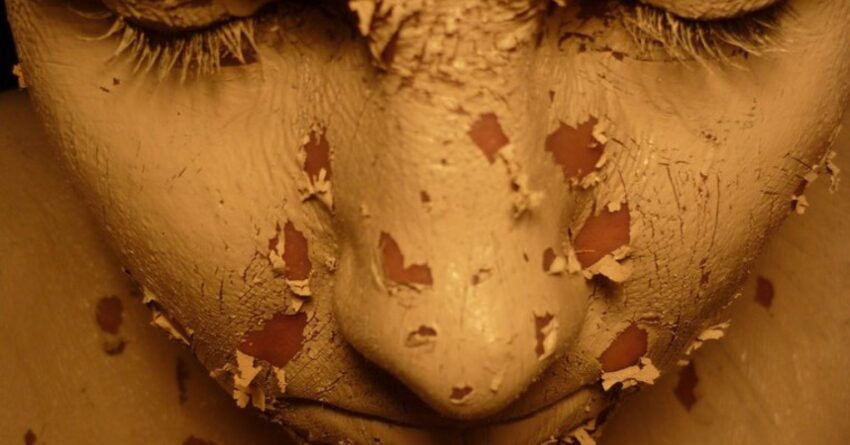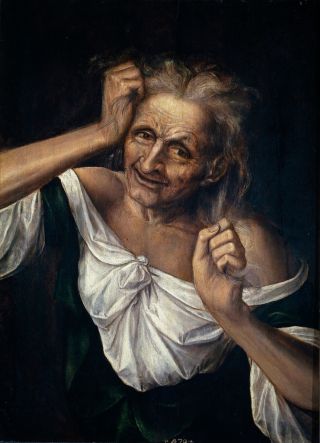
“Old Woman Tearing at her Hair” by Dutch artist Quentin Matsys, 16th century. Prado Museum, Madrid.
Source: Photo copyright Fine Arts Images/Bridgeman Images. Used with permission.
“When I heard this, I tore my tunic and cloak, pulled hair from my head and beard and sat down appalled…then, at the evening sacrifice, I rose from my self-abasement,” wrote Ezra, a scribe and priest of biblical fame (Ezra 9.1-13). The Israelites, forsaking holy commands, were intermarrying their sons and daughters with people from a “land polluted by corruption,” and Ezra, distraught by their sins, felt “too ashamed and disgraced” to lift his face to God.
Early references to hair-pulling due to psychological distress include Aristotle, who wrote of the “morbid state” of those who pluck out their hair and gnaw at their nails (Nicomachean Ethics), and Hippocrates, who described a woman with periodic fevers who plucked and picked at her hair (Epidemics III.)
“Tearing our hair out,” with examples from Homer to Shakespeare (Kim, 2014; Waas and Yesudian, 2018), is a common expression of frustration, exasperation, grief, or even madness that has persisted throughout the centuries.
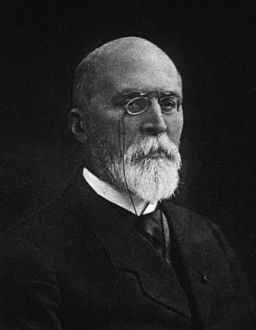
Francois Henri Hallopeau, a 19th-century dermatologist, coined the term “trichotillomania.”
Source: Wikimedia Commons/Public Domain.
There are those, however, who suffer from a compulsive urge to pull out their hair. It was 19th-century French dermatologist François Henri Hallopeau who first coined the term trichotillomania (Altmeyer, 2023; Hallopeau, 1899.) Hallopeau described a young man who developed alopecia per grattage—alopecia from scratching. His patient pulled out clumps of hair from his entire body, including his head, beard, pubic hair, eyebrows, and eyelashes, creating “artificially-induced” alopecia.
Trichotillomania, characterized by recurrent, irresistible hair-pulling, is a “psychiatric disorder with dermatologic consequences” (Ghani et al, 2024). It is part of the relatively new multidisciplinary field of psychodermatology “that explores the intricate interplay between the mind and the skin” and aims to remove the stigma and shame often inherent in the symptoms.
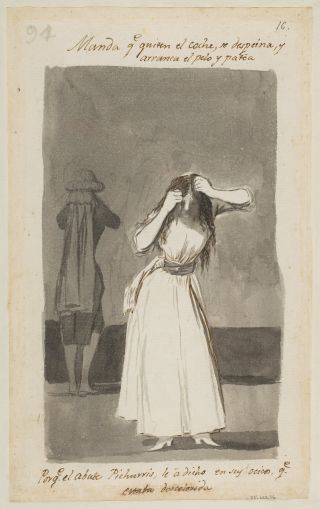
Woman throwing a tantrum and pulling her hair, by Spanish artist Francisco de Goya. Metropolitan Museum of Art, NYC.
Source: Credit: Harris Brisbane Dick Fund, 1935. Public Domain.
The prevalence of psychiatric disorders with dermatological symptoms presenting to dermatologists is estimated to be up to 30% to 40% (Turk et al, 2022).
Trichotillomania is one of the disorders, including skin picking, cheek chewing, and nail-biting, described under the “umbrella term” of body-focused repetitive behaviors (Christensen and Jafferany, 2024; Grant et al., 2024; Okumus and Akdemir, 2023).
Though there is a continuum in severity, these disorders may lead to significant physical damage (e.g., baldness, infection, severe skin excoriations) and psychosocial impairment (Odlaug and Grant, 2008). The prevalence “of clinically meaningful” body-focused repetitive behaviors varies between 0.5% and 4.4% (Okumus and Akdemir), but it may be considerably higher due to underreporting and failure to seek treatment (Malayala et al., 2021; Parsa et al., 2023).
Most, but not all studies, (Grant et al, 2023), indicate these behaviors are far more common in women (Odlaug and Grant). Trichotillomania often begins in adolescence (Odlaug and Grant) but can appear during childhood (Torales et al, 2021). Hair plucking most commonly occurs on the scalp, but like Hallopeau’s patient, it can involve any body part (Krishnan et al., 1985). The pattern of hair loss can be described as “bizarre with irregular borders” or even like a “Friar Tuck” appearance (França et al, 2019). There is often a genetic component, with family members experiencing symptoms, most commonly nail-biting (Grant et al, 2023).
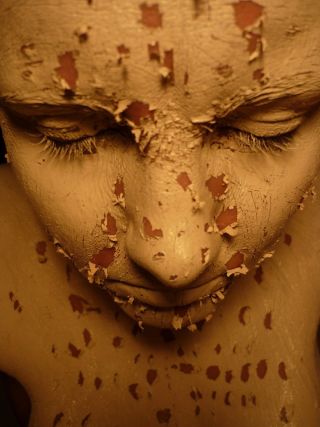
Artist’s rendition of skin picking by Liz Atkin, 2008. Acrylic.
Source: Wellcome Trust Collection. Copyright: Liz Atkin. All rights reserved. available online.
Skin picking, also called excoriation disorder or dermatillomania (Malayala et al.), has a bimodal pattern. It usually begins in the early 20s or between 30 and 45 years old (Odlaug and Grant). Without treatment, these behaviors tend to be chronic in most people (Grant et al., 2023).
Picking and plucking can be an automatic habit, without intention or awareness, or focused, with intention due to prior thoughts, sensations, or emotions (Parsa et al). Those who are focused hair pullers may explain that their hair feels different or odd (França et al), and those focused on skin picking may describe skin that appears uneven or discolored (Malayala et al).
Those without conscious awareness may have developed the habit as a form of self-soothing (Chamberlain et al, 2007) that became “functionally autonomous over time” (Parsa et al). Some patients have both picking and plucking symptoms, and those with concomitant symptoms can spend hours a day engaging in these repetitive behaviors (Odlaug and Grant).
Body-Focused Repetitive Behaviors Essential Reads
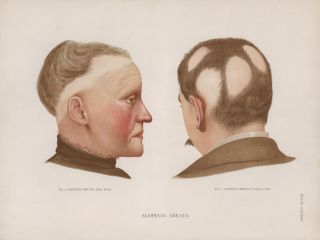
Alopecia areata, a dermatological condition not to be confused with trichotillomania. English School, 19th century lithograph.
Source: Copyright Look and Learn/Bridgeman Images. Used with permission.
When signs do present, and a patient does not acknowledge the behavior, a clinician must rule out other etiologies, including underlying diseases such as atopic dermatitis, thyroid or liver disorders, or those due to medications or vitamin deficiencies (Parsa et al.)
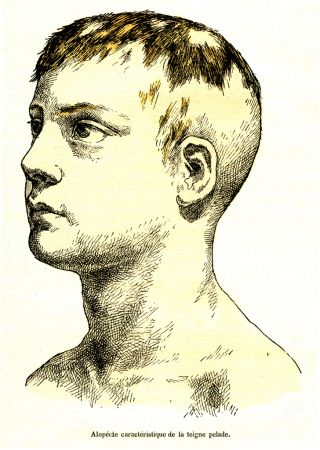
“Moth-eaten” alopecia, originally associated with secondary syphilis. 19th-century engraving.
Source: Photographer Patrice Carter. Copyright photo Gusman/Bridgeman Images. Used with permission.
A pattern of hair loss, described as moth-eaten alopecia, for example, originally characteristic of secondary syphilis, may result from other causes, including alopecia areata (Sharquie and Ahmed, 2021), an autoimmune disorder that causes non-scarring hair loss (Goldberg, 2023; Englander et al, 2023). Sometimes, clinicians must perform a biopsy for a diagnosis (Torales et al).
About 20% of those with trichotillomania will eat their hair (Grant and Chamberlain, 2016). There are rare cases in which patients with severe psychiatric illness present with abdominal pain from gastrointestinal obstruction due to a trichobezoar, a foreign body formed of undigested hair. When the tail of the hair extends from the stomach to the small intestine, it is referred to as the Rapunzel Syndrome (Moolamannil et al, 2023; Poirier et al, 2024).
Several theories account for the symptoms, including the stimulus regulation model, which indicates that hair, skin, and nails are quite sensitive and pleasantly rewarding to touch. Further, they may reflect the evolutionary role of grooming, whereby grooming has served the functions of hygiene, thermoregulation, social interaction, and stress regulation (Okumus and Akdemir).
Another theory implicates emotion regulation: the behaviors decrease unwanted negative emotions (Crowe et al, 2024), including boredom, disappointment, and unhappiness “as a result of a mismatch between unrealistic expectations and personal standards” (Okumus and Akdemir).

“There was an old man from Peru….” from “A Book of Nonsense.” c. 1875 by English artist Edward Lear. Private Collection.
Source: Copyright Look and Learn/Bridgeman Images. Used with permission.
In earlier versions of our Psychiatric Diagnostic and Statistical Manual (DSM III), trichotillomania and skin picking were categorized as impulse disorders, but by DSM 5, they are considered obsessive-compulsive disorders. Symptoms of anxiety, depression, and even substance abuse may exist concomitantly, as well as other obsessive-compulsive rituals such as checking in the mirror or even taking photos of the areas (Torales et al; Grant et al, 2023).
Various behavior modification techniques, including habit reversal therapy (Grant and Chamberlain) can help. These included behavioral contracts, self-monitoring, relaxation training, collecting hairs in an envelope, modifying the environment to reduce cues (Grant and Chamberlain), and even electrical aversive conditioning (Krishnan et al).
Along those lines, microneedling has been used as an adjunctive treatment for trichotillomania. This technique involves intentionally creating a wound that stimulates release factors involved in wound healing. Its effectiveness may result from the fact that it not only stimulates hair growth but reproduces the sensation of hair pulling (Christensen et al., 2022).

Spinario, attributed to Italian artist Antonello Gagini. Bronze sculpture, early 16th century. Metropolitan Museum of Art, NYC.
Source: Credit: Gift of George and Florence Blumenthal, 1932. Public Domain.
Clinicians have also tried various supplements and medications, including a glutamate modulator, such as N-acetylcysteine (Christensen and Jafferany), dopamine receptor blockers, such as olanzapine and aripiprazole (Okumus and Akdemir), opiate antagonists, such as naltrexone (Ghani et al), and anti-depressants, such as clomipramine or the SSRIs, all with limited success. There are no clear medication guidelines, and pharmacotherapy is often paired with behavioral modification.
Note: Special thanks to Ms. Arlene Shaner, Historical Collections Librarian at the New York Academy of Medicine, and Mr. Kevin Pain, Library Research Specialist at the Samuel J. Wood Library of Weill Cornell Medicine, for their assistance in retrieving references not readily accessible.
